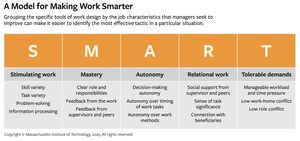MIT research based on over 1,000 studies pinpoints three high-impact ways to improve
CAMBRIDGE, Mass., Sept. 28, 2022 /PRNewswire/ -- According to new research released today in MIT Sloan Management Review, the three most powerful predictors of toxic workplace behavior are toxic leadership, toxic social norms, and work design. By identifying and addressing these factors, leaders can dramatically improve employees' experiences and minimize unwanted attrition, disengagement, negative word of mouth, and other costs associated with a toxic workplace.
The authors' previous research identified toxic culture as the primary driver of the Great Resignation, more than 10 times as powerful a factor as compensation.
"Toxic workplaces are far too common. Approximately 1 in 10 workers view their workplace culture as toxic, and they are sending a clear signal," said coauthor Donald Sull, a senior lecturer at the MIT Sloan School of Management and cofounder of CultureX. "They will no longer tolerate disrespect, exclusionary behavior, abuse, and other toxic behaviors. Organizational leaders face two choices: detox their corporate culture or the lose the war for talent."
More than 90% of North American CEOs and CFOs believe that improving their corporate culture would boost financial performance, and yet most executives acknowledge that their organization's culture is not as healthy as it should be.
If corporate culture is critical and needs work, why don't top leaders do more to improve it? Many aren't sure where to start, but time is crucial as the toxicity from a bad boss can linger long after they depart a leadership position.
Building on the previous research, Sull along with coauthor Charles Sull, cofounder of CultureX, use AI to measure and improve corporate culture. In "How to Fix a Toxic Culture," they share an authoritative evidence-based framework that managers can use to perform a cultural detox in their organizations. This includes interventions across the three main drivers of toxic culture:
Leadership. Leaders cannot improve corporate culture unless they are willing to hold themselves and their colleagues accountable for toxic behavior. CEOs can keep cultural detox on the agenda by linking cultural improvements to bottom-line benefits, such as lower attrition. Middle managers are 2.5 times more important in predicting employee misconduct compared with companywide factors.
Social Norms. Social norms, defined as behavior expected and acceptable in day-to-day social interactions, exist within organizations, specific teams, or departments, and they shape subcultures within the company. Toxic social norms increase the odds that even good people will behave poorly. Promoting uncollaborative employees to management can foster cutthroat subcultures that ultimately hurt the bottom line. Toxic leadership can negatively reshape social norms and influence behavior far beyond any one jerk manager's tenure, persisting through multiple changes in leadership.
Work Design. More than a century of research has pinpointed a handful of elements of work design, such as overall workload and conflicting job demands, that consistently predict important outcomes, including toxic behavior. Dozens of factors go into work design, but a few specific aspects are especially important in predicting employee stress. When rethinking work design, it's best to focus on elements of the job known to influence employee stress, such as reducing nuisance work, clarifying job descriptions and responsibilities, giving employees more control, and helping to reduce stress and improve sleep.
"Cultural change requires a holistic approach that incorporates multiple interventions and a sustained focus over time. Without a commitment from the top team, any organization wide culture change — including a cultural detox — is destined to fail," commented Sull.
Methodology
To find evidence-based insights on culture change, the authors began with the large body (more than 1,000 articles and studies) of existing research on unhealthy corporate culture. They first identified 11 meta-analyses, each of which synthesized existing research on specific elements of toxic culture. One meta-analysis, for example, aggregated the results of 140 separate studies analyzing the drivers of unethical behavior.
Then, they looked for common findings across the meta-analyses. Although they focused on different aspects of toxicity, such as disrespect, unethical behavior, and abusive management, the 11 meta-analyses converged on the same three factors as the most powerful predictors of toxic behavior in the workplace: toxic leadership, toxic social norms, and work design.
The MIT Sloan Management Review (MIT SMR) article, "How To Fix a Toxic Culture," publishes at 8 a.m. EDT on September 28.
Donald Sull (@culturexinsight) is a senior lecturer at the MIT Sloan School of Management, where he directs the Strategic Agility Project and the Culture 500. He is also the cofounder of CultureX, which leverages proprietary AI to measure and improve corporate culture. The Economist cited him as one of the thinkers who has shaped business management over the past century.
Charles Sull is a cofounder of CultureX. He also directs the Culture 500, and works with top teams around the world to measure and improve organizational culture. He has published several articles about related research in leading journals, including MIT Sloan Management Review.
MIT Sloan Management Review (MIT SMR) is an independent, research-based magazine and digital platform for business leaders, published at the MIT Sloan School of Management. MIT SMR explores how leadership and management are transforming in a disruptive world. We help thoughtful leaders capture the exciting opportunities — and face down the challenges — created as technological, societal, and environmental forces reshape how organizations operate, compete, and create value.
Connect with MIT Sloan Management Review, on:
Contact
Tess Woods
[email protected]
617-942-0336
SOURCE MIT Sloan Management Review

WANT YOUR COMPANY'S NEWS FEATURED ON PRNEWSWIRE.COM?
Newsrooms &
Influencers
Digital Media
Outlets
Journalists
Opted In






Share this article